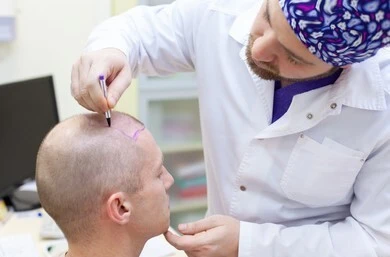Insufficient sleep and stress may not directly cause hair loss, but they can contribute to conditions leading to it and hair thinning.
9899424642
We have saved 10,000+ Aussies from hair loss with the right solution. Our celebrity
doctor, Dr Ajay Dubey, has performed 2,500+ surgeries across Indian and international
patients and is regarded as one of the
best hair transplant surgeons in Delhi.

BOOK YOUR
CONSULT
Evolved Hair Transplant Clinics at Gurgaon, Delhi and Lucknow have perfected the art of hair
transplants with 2 decades of research and innovation, which is captured in its evolutionary
protocols and its proprietary Direct Follicle Insertion technique.
We are adept in all types of hair transplant including hair and facial hair transplants for
both men and women, as well as repair and density corrections for previous FUT, FUE surgeries.
 100% natural, guaranteed permanent results.
100% natural, guaranteed permanent results.
 Painless, scar-free and fastest post-recovery.
Painless, scar-free and fastest post-recovery.
Evolved Hair Clinics Gurgaon, Delhi and Lucknow is delighted to join hands with one of the world’s most prolific hair transplant surgeons, Dr Ajay Dubey, who has dedicated his entire medical career of around 16 years to the field of hair transplants. Dr Dubey is the first surgeon in India to be certified by the London Hair Restoration Academy for consecutive 11 years and the only Asian doctor to be invited twice to deliver his research at the prestigious Aesthetic Medicine World Congress.
Dr. Dubey has completed over 2,500 hair transplants, many of which are top actors, sportsmen, politicians, beaureucrats, and industrialists. He is also an educator and has trained 30 doctors to become hair transplant surgeons from all over the world Dr Ajay Dubey completed M.D. in Dermatology and Venerology from IMS-BHU (currently ranked 5th in India), had a brief period of residency of AIIMS (currently ranked 1st in India) and completed M.B.B.S. from KGMC (currently ranked 4th in India).

Global Medical Director and Master Hair Transplant Surgeon

Dr Dubey’s Appreciation Certificate from AMWC, Latin America
.webp)

Dr Dubey’s views on Hair Transplant on NDTV

Dr Dubey’s lecture at AMWC, Latin America
From Bald to Bold, at Evolved Hair Restoration Clinics in Gurgaon, Delhi, and Lucknow, we transform the lives of people who suffer from baldness. Here’s how some folks embrace a new chapter of confidence and self-esteem.
Book a Hair Consultation at Gurgaon, Delhi, and Lucknow, and transform your look.


 Comprehensive Hair and Scalp analysis using the latest technology
Comprehensive Hair and Scalp analysis using the latest technology
 Discover the root cause of hair loss from an Internationally trained Trichologist
Discover the root cause of hair loss from an Internationally trained Trichologist
 Detailed medical health assessment
Detailed medical health assessment
 Learn how to immediately stop further hair loss
Learn how to immediately stop further hair loss
 Know the right Eye bro test restoration treatment to restore lost hair
Know the right Eye bro test restoration treatment to restore lost hair
Book Your Consultation Now & Get 50% OFF on Consultation Fees
View all Frequently Asked Questions (FAQ). Still in doubt? Do not hesitate to call us! We will be happy to help you out.